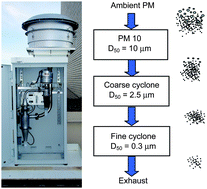Design and characterization of a sequential cyclone system for the collection of bulk particulate matter
Abstract
In this paper, we describe the design, development and characterization of a high-volume sequential

* Corresponding authors
a
Johns Hopkins University, Dept. of Environmental Health Sciences, 615 N Wolfe St E6628, Baltimore, MD, USA
E-mail:
arule@jhsph.edu
Fax: +1 (410) 955-9334
Tel: +1 (410) 502-5952
b Goucher College, 1021 Dulaney Valley Road, Baltimore, MD, USA
c Aerosol Sciences Team, RDECOM, Edgewood Chemical and Biological Center, 5183 Blackhawk RD, APG, MD, USA
d US Army Public Health Command, Air Quality Surveillance Program, 5158 Blackhawk Rd, Aberdeen Proving Ground, MD, USA
In this paper, we describe the design, development and characterization of a high-volume sequential

 Please wait while we load your content...
Something went wrong. Try again?
Please wait while we load your content...
Something went wrong. Try again?
A. M. Rule, A. S. Geyh, J. P. Ramos-Bonilla, J. N. Mihalic, J. D. Margulies, L. M. Polyak, J. Kesavan and P. N. Breysse, J. Environ. Monit., 2010, 12, 1807 DOI: 10.1039/C0EM00034E
To request permission to reproduce material from this article, please go to the Copyright Clearance Center request page.
If you are an author contributing to an RSC publication, you do not need to request permission provided correct acknowledgement is given.
If you are the author of this article, you do not need to request permission to reproduce figures and diagrams provided correct acknowledgement is given. If you want to reproduce the whole article in a third-party publication (excluding your thesis/dissertation for which permission is not required) please go to the Copyright Clearance Center request page.
Read more about how to correctly acknowledge RSC content.
 Fetching data from CrossRef.
Fetching data from CrossRef.
This may take some time to load.
Loading related content
